| |
TANAGERS Thraupidae |
- 378 species in the Neotropics
- DR personal total: 217 species (57%), 38 photo'd
|
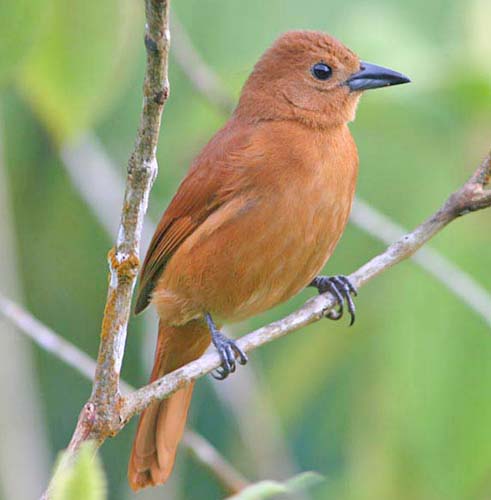 These aren't your father's Tanagers any more. These aren't your father's Tanagers any more.
The
Thraupidae page that was here in 2000 began: "No one is quite sure what
makes a 'tanager' right now, but as a Supreme Court justice once said
about pornography: 'I may not be able to define it, but I know it when
I see it.' Tanagers may be hard to define, but usually you know one
when you see one. They are just drop-dead gorgeous birds of the
Neotropics."
Well . . . wrong. Sort-of. Some of the
"drop-dead gorgeous birds" in the Neotropics are Tanagers, including
those in the speciose genus Tangara, like Silver-throated Tanager
(above). And a good many are traditional tanagers, such as White-lined
Tanager
(female, left). But a whole lot of the birds that appear
genetically to be tanagers go by different names. The full story may
surprise you. It is based on genetic evidence published within the
decade. [The most recent information is in Burns et al. (2014). That
has not yet been widely incorporated into this page. An update is
needed.] |
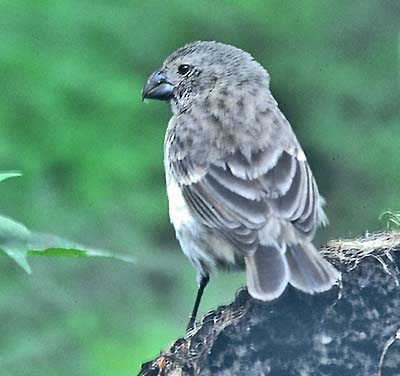 What
about the Western Tanager, which I featured on my previous version of
this family? Not a tanager — it belongs, to the Cardinalidae
[Cardinals, Grosbeaks & allies]. Same goes for Scarlet Tanager,
Summer Tanager, and Hepatic Tanager. Not tanagers. The sought-after
ant-tanagers of the tropical undergrowth? Not tanagers. The bright and
colorful chlorophonias and euphonias? Not tanagers. What
about the Western Tanager, which I featured on my previous version of
this family? Not a tanager — it belongs, to the Cardinalidae
[Cardinals, Grosbeaks & allies]. Same goes for Scarlet Tanager,
Summer Tanager, and Hepatic Tanager. Not tanagers. The sought-after
ant-tanagers of the tropical undergrowth? Not tanagers. The bright and
colorful chlorophonias and euphonias? Not tanagers.
So
what is a tanager? It's still hard to define, but the genetic evidence
is trickling in, and a lot of plain-colored birds appear to tanagers. Darwin's finches
on the Galapagos — such as Small Ground-Finch (right) — that may be a tanager. A seedeater on a tropic fenceline — like the male Variable Seedeater
(below) — that may be a tanager. The grassquits, Bananaquit, and the
saltators — they are all tanagers. These aren't your father's Tanagers
any more. |
|
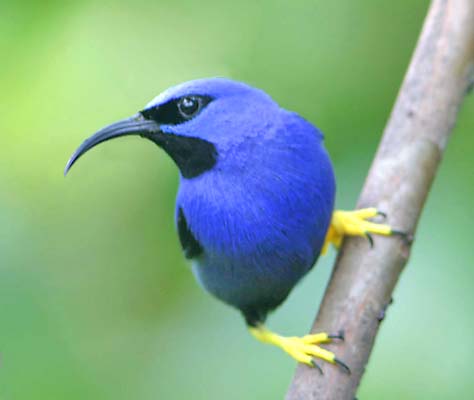 The
genetic evidence is impressive; e.g., Burns et al. (2002, 2003), Burns
& Naoki (2004), Yuri & Mindell (2002), Klicka et al. (2000,
2007). Workers in the past had paid too much attention to bill shape,
and not enough to biology, and convergent evolution masked many
relationships (Isler & Isler 1987). Thraupidae is now an entirely
Neotropical family whose members are essentially non-migratory.
Although little has yet been made official in new checklists,
tomorrow's Thraupidae should be a huge family of very diverse
Neotropical birds. With ~378 species, it is among the
largest bird families on earth. The "old" Thraupidae had ~ 242 species
(Isler & Isler 1987). Included now are many birds bearing the name
"tanager," but also many called finch, conebill, seedeater, dacnis, or
honeycreeper. Purple Honeyeater (left) is a widespread example of the latter. The
genetic evidence is impressive; e.g., Burns et al. (2002, 2003), Burns
& Naoki (2004), Yuri & Mindell (2002), Klicka et al. (2000,
2007). Workers in the past had paid too much attention to bill shape,
and not enough to biology, and convergent evolution masked many
relationships (Isler & Isler 1987). Thraupidae is now an entirely
Neotropical family whose members are essentially non-migratory.
Although little has yet been made official in new checklists,
tomorrow's Thraupidae should be a huge family of very diverse
Neotropical birds. With ~378 species, it is among the
largest bird families on earth. The "old" Thraupidae had ~ 242 species
(Isler & Isler 1987). Included now are many birds bearing the name
"tanager," but also many called finch, conebill, seedeater, dacnis, or
honeycreeper. Purple Honeyeater (left) is a widespread example of the latter.
|
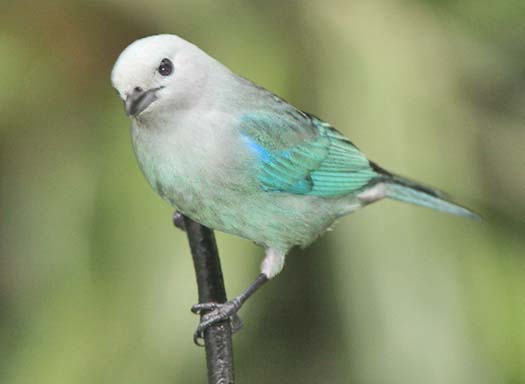 The genetic evidence divides the true tanagers into two groups. One group includes the original genus Thraupis, and its 9 species, including the very widespread and abundant Blue-gray Tanager (right). The genetic evidence divides the true tanagers into two groups. One group includes the original genus Thraupis, and its 9 species, including the very widespread and abundant Blue-gray Tanager (right).
This
is also the group that includes the honeycreepers, dacnises,
grassquits, seedeaters, Caribbean bullfinches, and Galapagos finches.
Among the surprises is that the various "cardinals" of South America,
in the genus Paroaria, fit into this set of tanagers. One of those is the widespread Red-capped Cardinal (below, a cool shot by Greg Lasley). |
|
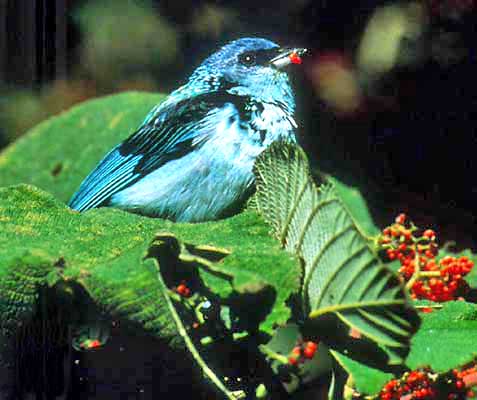 Among this set of tanagers is the genus Tangara (~50 species) are generally bright, gaudy, and travel in mixed-species flocks. Combining great loveliness and rarity is Azure-rumped Tanager
(left in a fantastic shot by Lou Jost). It is limited
to a narrow elevational range in the mountains of Chiapas, Mexico, and
adjacent western Guatemala. Among this set of tanagers is the genus Tangara (~50 species) are generally bright, gaudy, and travel in mixed-species flocks. Combining great loveliness and rarity is Azure-rumped Tanager
(left in a fantastic shot by Lou Jost). It is limited
to a narrow elevational range in the mountains of Chiapas, Mexico, and
adjacent western Guatemala.
It is the Andes where the Tangara
tanagers really shine. One encounters mixed-species flocks which
include a dozen or more species, some with such alliterative names as
Beryl-spangled Tanager T. nigroviridis, Spangle-cheeked Tanager T. dowii, or Flame-faced Tanager T. parzudakii. The foothills have birds like Bay-headed Tanager (below left). The Amazonian lowlands have fewer species, but the widespread Paradise Tanager T. chilensis is as gaudy as they come. |
|
The eye-popping Tangara tanagers are not the only glittering group in the family. I rather like the mountain-tanagers (genus Anisognathus) which include such stunners as the Blue-winged Mountain-Tanager
(above right). This is a reasonably common bird in cloud forest of the
Andes, and even if its range does stretch from Venezuela to Bolivia,
how can one tire of seeing another? The Bangsia tanagers of dense mossy Andean forests, the Iridosornis tanagers of the temperate zone, and the unbelievable Glistening-green Tanager Chorochrysa phoenicotis and Multicolored Tanager C. nitidissima,
both endemic to the west slope of the subtropical Andes in sw. Colombia
and nw. Ecuador, are among the most spectacular birds in the world
(wonderful photos of briefly-captured birds are in Dunning 1970). |
|
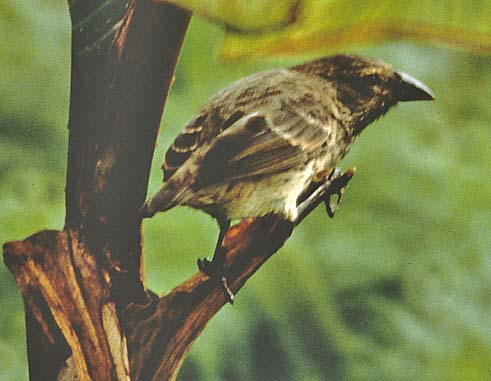 Some genetic data indicate that the Galapagos finches — represented here by Woodpecker Finch (right) — are embedded within the Thraupidae as part of a group that includes Yellow-faced Grassquit (above left), Bananaquit (above right), and several Caribbean genera (Burns et al. 2002, 2003, Yuri and Mindell 2002, Klicka et al. 2000, 2007). Some genetic data indicate that the Galapagos finches — represented here by Woodpecker Finch (right) — are embedded within the Thraupidae as part of a group that includes Yellow-faced Grassquit (above left), Bananaquit (above right), and several Caribbean genera (Burns et al. 2002, 2003, Yuri and Mindell 2002, Klicka et al. 2000, 2007).
The relationships of all these species have long been controversial. The grassquit is in genus Tiaris, but Tiaris
itself is paraphyletic, with Yellow-faced Grassquit, the type species
of the genus, not being not particularly close to other "Tiaris."
Grassquits had once been placed with the cardinalines, and then with
the emberizines based on skeletal morphology (e.g., AOU 1957). Now they
are all tanagers; Burns et al. (2014).
The
Galapagos finches were once placed
in a separate subfamily [Geospizinae] from other sparrows and finches
in the family Emberizidae. Their origins have been a point of
contention back to the days of Darwin. They are often called "Darwin's
Finches" because of their mythologized influence on his theory of
evolution (in truth Darwin did not pay much attention to the finches;
he was more impressed with variation in mockingbirds and tortoises).
They
have themselves been the subject of extensive study, including the
amazing work of Peter & Rosemary Grant (Weiner 1994).
Until
recently, the relationships of Bananaquit remained unresolved; some
thought it a parulid warbler but many have considered it a monotypic
family (e.g., AOU 1998) or subfamily (Ridgely & Tudor 1989).
Bledsoe (1988) included it within the Thraupidae; Sibley & Monroe
(1990) also thought it was a tanager (which they considered to be just
a tribe Thraupini of a huge Fringillidae family). [It is possible that
someday scientists will lump all the families near the end of the
passerines — tanagers, emberizids, finches, New World warblers,
icterids, cardinals & grosbeaks — into a single humongous family on
the grounds that they all evolved comparatively recently, in contrast
to longer-evolved families, but let's hope it doesn't go that far!] The
SACC even considered Bananaquit a family until 2007. It is now
clearly a tanager. |
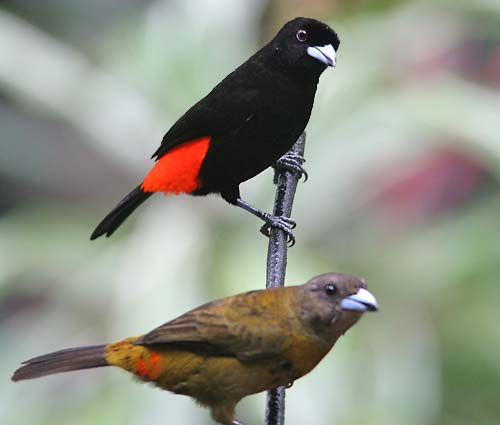 There is a second major group in the "new" Thraupidae. A basal set in this other group are 9 species of brightly-patterned Ramphocelus tanagers. I've heard that, spectrographically, the intense red on male Ramphocelus is the brightest red in the bird world. There is a second major group in the "new" Thraupidae. A basal set in this other group are 9 species of brightly-patterned Ramphocelus tanagers. I've heard that, spectrographically, the intense red on male Ramphocelus is the brightest red in the bird world.
Passerini's Tanager
(left) is one of them, and there is strong sexual dimorphism (male
above, female below). This used to be called 'Scarlet-rumped Tanager.'
While males look alike throughout its range, the females in western
Costa Rica are decidedly different. 'Scarlet-rumped' has recently been
split into Passerini's (the widespread bird of Atlantic lowlands from
Mexico to Panama) and Cherrie's (on the Pacific slope of Costa Rica).
Another Ramphocelus is the gorgeous burgundy-velvet Silver-beaked Tanager (male; below left). |
|
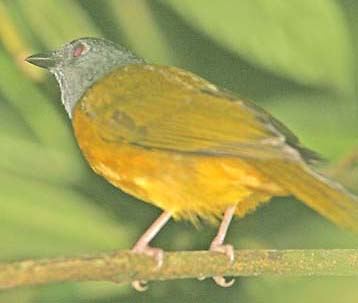 A
number of undergrowth skulkers are in this set of tanagers, including
the "crested" tanagers in genus Tachyphonus. These are birds like
Flame-crested Tanager T. cristatus and Fulvous-crested Tanager T. surinamus, and non-crested species such as White-lined Tanager
(male, above right; the female was shown at the top of this family
page). The "white line" is actually a bit of the underwing coverts
visible in normal views (above right). A
number of undergrowth skulkers are in this set of tanagers, including
the "crested" tanagers in genus Tachyphonus. These are birds like
Flame-crested Tanager T. cristatus and Fulvous-crested Tanager T. surinamus, and non-crested species such as White-lined Tanager
(male, above right; the female was shown at the top of this family
page). The "white line" is actually a bit of the underwing coverts
visible in normal views (above right).
Gray-headed Tanager (right) is in its own genus; it joins flocks of other species in the lowland undergrowth. Shrike-tanagers, genus Lanio, are placed here. So are the honeycreepers — represented here by Shining Honeycreeper (below left) — plus conebills (genus Conirostrum), Giant Conebill (Oreomanes), and Tit-like Dacnis (Xenodacnis). |
|
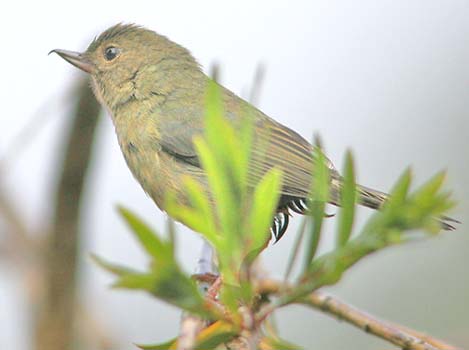 This second set of tanagers includes numerous anomalous species. Slender-billed Finch
(above center) is has a thin, bright yellow, finch-like bill; it is
restricted to arid scrub in coastal south Peru and north Chile. The Plushcap
(above right) is restricted to bamboo thickets high in the Andes. It is
so atypical that for many years it was considered to be in its own
family ["Catamblyrhynchidae"]. The Pardusco Nephelornis onelli is an oddity found only in isolated elfin forests in central Peru. Tanager-Finch Oreothraupis arremonops likes lush Pacific slope cloud forests. Hemispingus is a genus of tanagers [but Chlorospingus bush-tanagers are emberizids]. This second set of tanagers includes numerous anomalous species. Slender-billed Finch
(above center) is has a thin, bright yellow, finch-like bill; it is
restricted to arid scrub in coastal south Peru and north Chile. The Plushcap
(above right) is restricted to bamboo thickets high in the Andes. It is
so atypical that for many years it was considered to be in its own
family ["Catamblyrhynchidae"]. The Pardusco Nephelornis onelli is an oddity found only in isolated elfin forests in central Peru. Tanager-Finch Oreothraupis arremonops likes lush Pacific slope cloud forests. Hemispingus is a genus of tanagers [but Chlorospingus bush-tanagers are emberizids].
Also here are some 14 species of Diglossa flowerpiercers, represented here by Slaty Flowerpiercer
(female right; males are black). The strange upturned, hook-tipped bill
is used to pierce the base of flowers to get at the nectar there. |
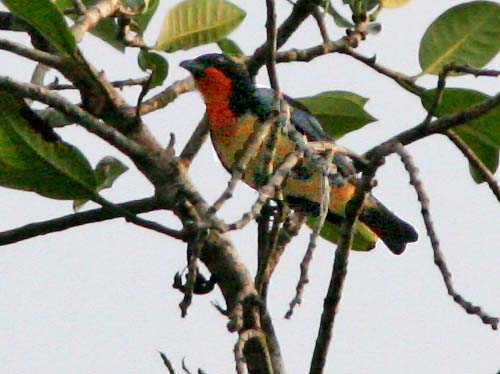 Orange-throated Tanager
(left © Dan Singer, among the few to photo this rarity) was only
discovered to science in 1964 (Lowery & O'Neill 1964); the
fascinating story of this "bird without a name" is told by Stap (1991).
Wetmorethraupis is a monotypic genus and remains
rare and hard to find near
the Rio Marañón, and restricted to a narrow altitudinal range
(600-800m) in mature forest in northern Peru and southernmost Ecuador. The list of local and endemic species
among the tanagers is quite long. Orange-throated Tanager
(left © Dan Singer, among the few to photo this rarity) was only
discovered to science in 1964 (Lowery & O'Neill 1964); the
fascinating story of this "bird without a name" is told by Stap (1991).
Wetmorethraupis is a monotypic genus and remains
rare and hard to find near
the Rio Marañón, and restricted to a narrow altitudinal range
(600-800m) in mature forest in northern Peru and southernmost Ecuador. The list of local and endemic species
among the tanagers is quite long.
Thraupidae
is such a huge family that we can barely skim the surface here. I've
gotten this far without mentioning the enigmatic Swallow-Tanager Tersina viridis,
once thought to be in its own monotypic family ["Tersinidae"]. There
are also many special tanagers that are exceptionally rare and elusive.
Cherry-throated Tanager Nemosia rourei had previously been
known only from a specimen in southeast Brazil from 1870 and one report
47 years ago, but was just recently rediscovered (you can read about
this find, and see photos, in Pacheco 1998). |
For
a time there was mystery as to the placement of saltators. They have
long been considered with cardinals and grosbeaks,
but genetic evidence shows this was wrong. Burns et al. (2014)
determined they were solidly "tanagers." They found that 15 of the 16
species of Saltator
formed a distinctive clade, worthy of subfamily status, and named the
clade Saltatorinae. This subfamily includes the very widespread Buff-throated Saltator (below). The exception was Rufous-bellied Saltator "Saltator" rufiventris
of the eastern Andes of southern Bolivia and extreme northern
Argentina. It is apparently close to mountain-tanagers, but needs a new
genera. [As of this update, the paper proposing generic changes is
still unpublished.] |
|
It is my hope
that the ornithologists don't tinker too much with the name "tanager."
We have birds in many different families that are called "chat," or
"finch," or "redstart." Just because Slender-billed Finch is now a
tanager does not mean it is wise to revise the English name and cause
literary confusion of years. I can live with some small changes here or
there — "Stripe-headed Tanager" became Stripe-headed Spindalis without
much problem — and, in fact, the genus Spindalis is now in different family, the Phoenicophilidae — but my plea would be to avoid wholesale English name
changes in the quest for the "perfect" name. Yet, in the end, no matter
how a "tanager" eventually comes to be defined or named, these are
fascinating and often colorful birds of the Neotropics. They, with
hummingbirds, parrots, and toucans, are a core component of any
Neotropical adventure.
I have another page focused mostly on tanagers endemic to coastal Brazil. Someday some of these photos should be moved over to this discusion. |
| |
Photos: The Silver-throated Tanager Tangara icterocepala was at Mirador Cinchona, Costa Rica, on 18 Dec 2007. The female White-lined Tanager Tachyphonus rufus was at Asa Wright Nature Reserve, Trinidad, on 24 Dec 2006, as was the male shown farther down the page. The female Small Ground-Finch Geospiza fuliginosa was on Santa Cruz I., Galapagos, on 25 Sep 1989. The male Variable Seedeater Sporophila aurita was near Puerto Viejo, Costa Rica, on 17 Dec 2007. The male Purple Honeyeater Cyanerpes caeruleus was at Asa Wright, Trinidad, on 25 Dec 2006. The Blue-gray Tanager Thraupis episcopus was at Puerto Viejo, Costa Rica, on 17 Dec 2007. Greg Lasley photographed the bathing Red-capped Cardinal Paroaria gularis at Hato el Cedros, Venezuela, on 25 Apr 1992. The wonderful berry-eating Azure-rumped Tanager Tangara cabanisi was photographed by Lou Jost at Canyon Hondo, below El Triunfo, Chiapas, Mexico, in 1986. The acrobatic Bay-headed Tanager Tangara gyrola was on the Osa Peninsula, Costa Rica, on 26 Dec 2007. The Blue-winged Mountain-Tanager Anisognathus somptuosus was foraging with a canopy flock below a ridge on the Nono-Mindo Road, Ecuador, in April 1992. The Yellow-faced Grassquit Tiaris olivacea was on Cozumel Is., Mexico, on Sep . The Bananaquit Coereba flaveola was at Asa Wright, Trinidad, on 24 Dec 2006. The Woodpecker Finch Camarhynchus pallidus was on Santa Cruz I., Galapagos, on 25 Sep 1989. The pair of Passerini's Tanager Ramphocelus passerinii was at Puerto Viejo, Costa Rica, on 19 Dec 2007. The male Silver-beaked Tanager R. carbo was at Asa Wright, Trinidad, on 25 Dec 2006. The Gray-headed Tanager Eucometis penicillata was in a mixed flock at Bosque del Rio Tigre, Osa Peninsula, Costa Rica, on 25 Dec 2007. The Shining Honeycreeper Cyanerpes lucidus was at Puerto Viejo, Costa Rica, on 19 Dec 2007. The Plushcap Catamblyrhynchus diadema was in bamboo below Abra Malaga, Dept. Cuzco, Peru, on 17 June 1987. The Slaty Flowerpiercer Diglossa plumbea was at Savegre, Costa Rica, on 23 Dec 2007. Dan Singer photographed the Orange-throated Tanager Wetmorethraupis sterrhopteron on 23 Sep 2005 at Nuevo Salem, Peru. The Buff-throated Saltator Saltator maximus was at Puerto Viejo, Costa Rica, on 20 Dec 2007. All photos © Don Roberson, except those credited © Lou Jost, © Greg W. Lasley, and © Dan Singer, and used with permission; all rights reserved.
Bibliographic essay
Family Book: 
Isler, M. L., and P. R. Isler. 1987. The Tanagers: Natural History, Distribution, and Identification. Smithsonian Institution Press, Washington, D. C.
Writing
in 1987, when the DNA-DNA hybridization studies by Sibley &
Ahlquist (1990) were just advance rumors, Isler & Isler wrote this
about tanagers, which they had already reduced them to a subfamily, the
Thraupinae:
"Tanagers
belong to a very large group of birds known as nine-primaried oscines
(or songbirds)... Characteristics have never been found that
distinguish clearly among the subgroups of New World nine-primaried
oscines commonly known as wood-warblers, tanagers, cardinals, and
buntings (citations omitted). Despite the unclear boundaries, bill
shape and presumed feeding behavior have been used to define families
or subfamilies. Wood-warblers generally have slender pointed bills and
feed mostly on insects, tanagers have thicker bills (some with a notch
on the upper mandible) and eat mostly fruit, and New World finches have
the stoutest bills and take mostly seeds. . . . Bill form and feeding
habits appear less and less to be a good reflection of phylogenetic
relationships among the New World nine-primaried songbirds. Recent
studies have shown that bill form can change quite rapidly in
evolutionary time [and] feeding behaviors within each of the three
groups . . . have been found to be highly variable. . . . Despite the
increasing certainty that tanagers are not presently definable as a
monophyletic group we employ the rather traditional taxonomic
arrangement . . . . It will take many years to reassess the
relationships among the New World nine-primaried songbirds, and in the
meantime, it is convenient and appropriate to use a well-known existing
taxonomy. Even within the confines of this taxonomy, tanagers exhibit a
remarkable variety of morphology and behavior."
The
Islers were prescient. Things would change, and yet the book remains
solid. It is not in any of the "regular" series of family books, which
makes a refreshing change. It is more thorough and scholarly than most
family volumes in the past two decades. Indeed, reading the
acknowledgements is like reading the "all-star" line-up for Neotropical
ornithology: Steve Hilty, the late & great Ted Parker, and Bob
Ridgely "were the principal reviewers," and Gary Graves, John O'Neill,
Van Remsen & Tom Schulenberg "reviewed large sections of the book."
This is possibly as authoritative as any recent similar effort for any
family in the world, and for that the reader is intensively grateful.
I especially like the distribution maps which show all the major rivers
of the Neotropics so one can easily get a feel for the range of the
species (e.g., either within a watershed or many, or restricted to
mountains between watersheds). Maps focus on either South or Central
America, depending on the species involved. Besides the maps, the
discussions of subspecific variation is good; details of vocalizations
are excellent; and the habitat, behavior, and natural history
information is outstanding. The plates — in field guide style by Morton
Isler — are accurate, even if not particularly evocative.
All that having been said, there are a few criticisms. First, the book
should probably have been called "The Tanagers of the Neotropics"
because the three primarily North American breeding species (Western,
Scarlet, Summer) are treated as an afterthought. This proved accurate
in the long run — these would prove to be in the Cardinalidae — but
here are no breeding range maps for these, and the map for Hepatic
Tanager cuts off at mid-Mexico with the phrase "extends to southeastern
U.S." [sic]. This typographical mistake (obviously, southwestern
U.S. was intended) is illustrative of the [lack of] care given to birds
north of the border. The primary sources cited tend to be the Bent
series (from 1956!) and earlier. Secondly, the plates, albeit accurate
enough for i.d. purposes, do not capture the breath-taking beauty of
these birds. The Glistening-green Tanager Chorochrysa phoenicotis, for example, just knocks your socks off in the field! [See spectacular photos in Dunning 1970]. Here, it is a dull green bird.
Yet these drawbacks detract little from the outstanding text. For the
real scoop on the 'traditional' tanagers this is the book. Also see the recently-published chapter in the Handbook of Birds of the World project.
Literature cited:
American Ornithologists' Union. 1957. Check-List of North American Birds. 5th ed. A.O.U., Washington, D. C.
American Ornithologists' Union. 1998. Check-List of North American Birds. 7th ed. A.O.U., Washington, D. C.
Barker,
F.K., K.J. Burns, J. Klicka, S.M. Lanyon, and I.J. Lovette. 2013. Going
to extremes: contrasting rates of diversification in a recent radiation
of New World passerine birds. Syst. Biol. 62: 298-320.
Bledsoe, A. H. 1988. Nuclear DNA evolution and phylogeny of the New World nine-primaried oscines. Auk 105: 504-515.
Burns,
K.J., S.J. Hackett, and N.K. Klein. 2002. Phylogenetic relationships
and morphological diversity in Darwin's finches and their relatives.
Evolution 56: 1240-1252.
Burns, K.J., S.J. Hackett,
and N.K. Klein. 2003. Phylogenetic relationships of Neotropical
honeycreepers and the evolution of feeding morphology. J. Avian Biology
34: 360-370.
Burns, K.J., and K. Naoki. 2004. Molecular phylogenetics and biogeography of Neotropical tanagers in the genus Tangara. Molec. Phylog. Evol. 32: 838-854.
Burns,
K.J., A.J. Schultz, P.O. Title, N.A. Mason, F.K. Barker, J. Klicka,
S.M. Lanyon, and I.J. Lovette. 2014. Phylogenetics and diversification
of tanagers (Passeriformes: Thraupidae), the largest radiation of
Neotropical songbirds. Molec. Phylo. Evol. 75: 41-77.
Dunning, J. S. 1970. Portraits of Tropical Birds. Livingston Publ. Co., Wynnewood, PA.
Klicka, J., K. Burns, and G.M. Spellman. 2007. Defining a monophyletic
Cardinalini: A molecular perspective. Molec. Phylog. Evol. 45: 1014
1032.
Klicka, J., K. P. Johnson, and S. M. Lanyon.
2000. New World nine-primaried oscine relationships: constructing a
mitochondrial DNA framework. Auk 117: 321-336.
Lowery, G. H., Jr., and J. P. O'Neill. 1964. A new genus and species of tanager from Peru. Auk 81: 125-131.
Pacheco, J. F. 1998. Cherry-throated Tanager Nemosia rourei rediscovered. Cotinga 9: 41.
Ridgely, R. S., and G. Tudor. 1989. The Birds of South America. Vol. 1: The Oscine Passerines. Univ of Texas, Austin.
Sibley, C. G., and J. E. Ahlquist. 1990. Phylogeny and Classification
of Birds: A Study in Molecular Evolution. Yale Univ. Press, New Haven,
CT.
Sibley, C. G., and B. L. Monroe. 1990. Distribution and Taxonomy of Birds of the World. Yale Univ. Press, New Haven, CT.
Stap, D. 1991. A Parrot without a Name: The Search for the Last Unknown Birds on Earth. Alfred A. Knopf, New York.
Weiner, Jonathan. 1994. The Beak of the Finch: A Story of Evolution in Our Time. Knopf, New York.
Yuri,
T., and D.P. Mindell. 2002. Molecular phylogenetic analysis of
Fringillidae, "New World nine-primaried oscines" (Aves: Passeriformes).
Molec. Phylog. Evol. 23: 229-243.
|
|
|




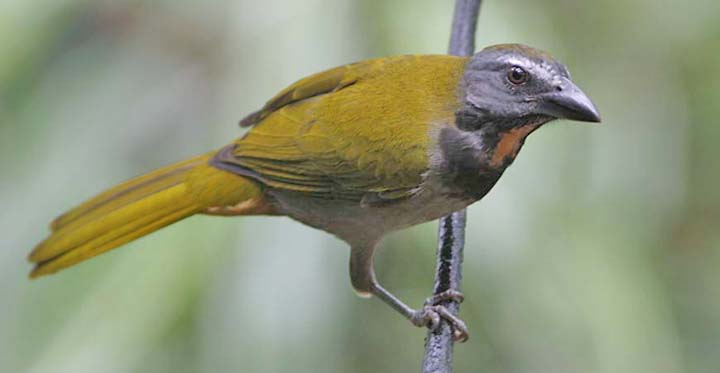
 These aren't your father's Tanagers any more.
These aren't your father's Tanagers any more. What
about the Western Tanager, which I featured on my previous version of
this family? Not a tanager — it belongs, to the Cardinalidae
[
What
about the Western Tanager, which I featured on my previous version of
this family? Not a tanager — it belongs, to the Cardinalidae
[ The
genetic evidence is impressive; e.g., Burns et al. (2002, 2003), Burns
& Naoki (2004), Yuri & Mindell (2002), Klicka et al. (2000,
2007). Workers in the past had paid too much attention to bill shape,
and not enough to biology, and convergent evolution masked many
relationships (Isler & Isler 1987). Thraupidae is now an entirely
Neotropical family whose members are essentially non-migratory.
Although little has yet been made official in new checklists,
tomorrow's Thraupidae should be a huge family of very diverse
Neotropical birds. With ~378 species, it is among the
largest bird families on earth. The "old" Thraupidae had ~ 242 species
(Isler & Isler 1987). Included now are many birds bearing the name
"tanager," but also many called finch, conebill, seedeater, dacnis, or
honeycreeper. Purple Honeyeater (left) is a widespread example of the latter.
The
genetic evidence is impressive; e.g., Burns et al. (2002, 2003), Burns
& Naoki (2004), Yuri & Mindell (2002), Klicka et al. (2000,
2007). Workers in the past had paid too much attention to bill shape,
and not enough to biology, and convergent evolution masked many
relationships (Isler & Isler 1987). Thraupidae is now an entirely
Neotropical family whose members are essentially non-migratory.
Although little has yet been made official in new checklists,
tomorrow's Thraupidae should be a huge family of very diverse
Neotropical birds. With ~378 species, it is among the
largest bird families on earth. The "old" Thraupidae had ~ 242 species
(Isler & Isler 1987). Included now are many birds bearing the name
"tanager," but also many called finch, conebill, seedeater, dacnis, or
honeycreeper. Purple Honeyeater (left) is a widespread example of the latter.  The genetic evidence divides the true tanagers into two groups. One group includes the original genus Thraupis, and its 9 species, including the very widespread and abundant Blue-gray Tanager (right).
The genetic evidence divides the true tanagers into two groups. One group includes the original genus Thraupis, and its 9 species, including the very widespread and abundant Blue-gray Tanager (right). Among this set of tanagers is the genus Tangara (~50 species) are generally bright, gaudy, and travel in mixed-species flocks. Combining great loveliness and rarity is Azure-rumped Tanager
(left in a fantastic shot by Lou Jost). It is limited
to a narrow elevational range in the mountains of Chiapas, Mexico, and
adjacent western Guatemala.
Among this set of tanagers is the genus Tangara (~50 species) are generally bright, gaudy, and travel in mixed-species flocks. Combining great loveliness and rarity is Azure-rumped Tanager
(left in a fantastic shot by Lou Jost). It is limited
to a narrow elevational range in the mountains of Chiapas, Mexico, and
adjacent western Guatemala.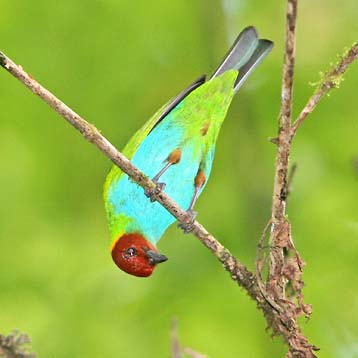
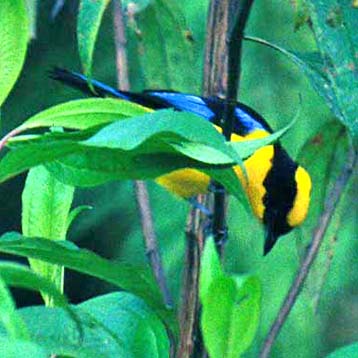

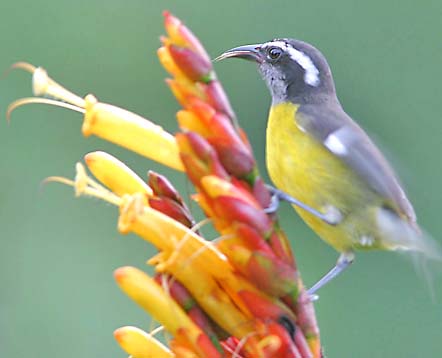
 Some genetic data indicate that the Galapagos finches — represented here by Woodpecker Finch (right) — are embedded within the Thraupidae as part of a group that includes Yellow-faced Grassquit (above left), Bananaquit (above right), and several Caribbean genera (Burns et al. 2002, 2003, Yuri and Mindell 2002, Klicka et al. 2000, 2007).
Some genetic data indicate that the Galapagos finches — represented here by Woodpecker Finch (right) — are embedded within the Thraupidae as part of a group that includes Yellow-faced Grassquit (above left), Bananaquit (above right), and several Caribbean genera (Burns et al. 2002, 2003, Yuri and Mindell 2002, Klicka et al. 2000, 2007). There is a second major group in the "new" Thraupidae. A basal set in this other group are 9 species of brightly-patterned Ramphocelus tanagers. I've heard that, spectrographically, the intense red on male Ramphocelus is the brightest red in the bird world.
There is a second major group in the "new" Thraupidae. A basal set in this other group are 9 species of brightly-patterned Ramphocelus tanagers. I've heard that, spectrographically, the intense red on male Ramphocelus is the brightest red in the bird world.
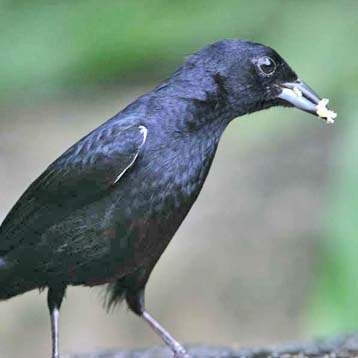
 A
number of undergrowth skulkers are in this set of tanagers, including
the "crested" tanagers in genus Tachyphonus. These are birds like
Flame-crested Tanager T. cristatus and Fulvous-crested Tanager T. surinamus, and non-crested species such as White-lined Tanager
(male, above right; the female was shown at the top of this family
page). The "white line" is actually a bit of the underwing coverts
visible in normal views (above right).
A
number of undergrowth skulkers are in this set of tanagers, including
the "crested" tanagers in genus Tachyphonus. These are birds like
Flame-crested Tanager T. cristatus and Fulvous-crested Tanager T. surinamus, and non-crested species such as White-lined Tanager
(male, above right; the female was shown at the top of this family
page). The "white line" is actually a bit of the underwing coverts
visible in normal views (above right). 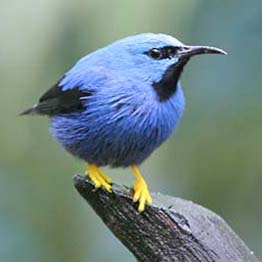

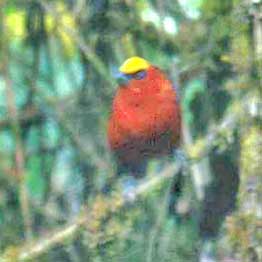
 This second set of tanagers includes numerous anomalous species. Slender-billed Finch
(above center) is has a thin, bright yellow, finch-like bill; it is
restricted to arid scrub in coastal south Peru and north Chile. The Plushcap
(above right) is restricted to bamboo thickets high in the Andes. It is
so atypical that for many years it was considered to be in its own
family ["Catamblyrhynchidae"]. The Pardusco Nephelornis onelli is an oddity found only in isolated elfin forests in central Peru. Tanager-Finch Oreothraupis arremonops likes lush Pacific slope cloud forests. Hemispingus is a genus of tanagers [but Chlorospingus bush-tanagers are emberizids].
This second set of tanagers includes numerous anomalous species. Slender-billed Finch
(above center) is has a thin, bright yellow, finch-like bill; it is
restricted to arid scrub in coastal south Peru and north Chile. The Plushcap
(above right) is restricted to bamboo thickets high in the Andes. It is
so atypical that for many years it was considered to be in its own
family ["Catamblyrhynchidae"]. The Pardusco Nephelornis onelli is an oddity found only in isolated elfin forests in central Peru. Tanager-Finch Oreothraupis arremonops likes lush Pacific slope cloud forests. Hemispingus is a genus of tanagers [but Chlorospingus bush-tanagers are emberizids].  Orange-throated Tanager
(left © Dan Singer, among the few to photo this rarity) was only
discovered to science in 1964 (Lowery & O'Neill 1964); the
fascinating story of this "bird without a name" is told by Stap (1991).
Wetmorethraupis is a monotypic genus and remains
rare and hard to find near
the Rio Marañón, and restricted to a narrow altitudinal range
(600-800m) in mature forest in northern Peru and southernmost Ecuador. The list of local and endemic species
among the tanagers is quite long.
Orange-throated Tanager
(left © Dan Singer, among the few to photo this rarity) was only
discovered to science in 1964 (Lowery & O'Neill 1964); the
fascinating story of this "bird without a name" is told by Stap (1991).
Wetmorethraupis is a monotypic genus and remains
rare and hard to find near
the Rio Marañón, and restricted to a narrow altitudinal range
(600-800m) in mature forest in northern Peru and southernmost Ecuador. The list of local and endemic species
among the tanagers is quite long. 